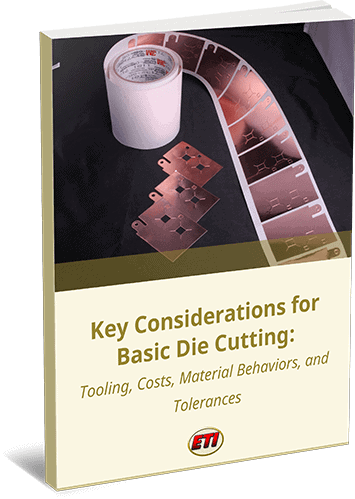Die cutting is a precise and versatile manufacturing process used to cut, shape, or form various materials. This technique employs specialized tools known as dies often made of sharp steel to meticulously cut through paper, cardboard, fabric, plastic, and even metal. The process finds wide applications in crafting products where precision and consistency are paramount, such as packaging, labels, envelopes, gaskets, seals and more.
Elastomer Technologies, Inc. (ETI) stands out as a seasoned die cutting expert. With over 35 years of experience, we excel in custom die cutting and high-speed stamping services. Our facility is fully equipped with cutting-edge machinery, including high-speed automatic Preco work centers, clickers, traveling heads, and punch presses to accommodate your varying needs.
The Core Principles of Die Cutting
Here are the key principles that contribute to die cutting’s efficiency, accuracy, and versatility:
Die Usage
The die cutting process revolves around utilizing specialized tools known as dies. These are typically made of sharp steel and are custom-designed to cut through specific materials precisely. Choosing die material and design is critical to ensuring accurate and consistent cuts.
Material Compression
As the die presses into the material, there is a controlled compression that takes place. This keeps the material in place, allowing for clean and accurate cuts. Understanding the properties of the material being cut is essential for precise and effective compression.
Clean Cutting Edges
Achieving clean cutting edges is a primary goal in die cutting. The design and sharpness of the die play a crucial role in determining the quality of the cut edges. This results in components that are not only aesthetically pleasing but also functionally optimal and durable.
Waste Removal
Die cutting is a subtractive manufacturing technique, which means that scrap materials are produced during the process. Effective waste removal mechanisms such as vacuum systems or specialized tools — are employed to promptly clear away excess material, enhancing productivity and ensuring cut accuracy.
Types of Die Cutting
There are various types of die cutting methods used for various applications and materials, including:
Flatbed Die Cutting
In this classic die cutting method, the material is put on a flat surface. A flatbed press with a mounted die then applies pressure to accurately cut intricate designs in materials like paper and cardboard.
Clicker-Type Die Cutting
Clicker presses with equipped dies are used to cut shapes by descending onto the material. This method is particularly well-suited for softer materials such as leather, fabric, and gaskets, providing high precision and control over the cutting process.
High-Speed Die Cutting
High-speed die cutting leverages advanced machinery capable of swift and continuous cutting. It is ideal for large-scale production with high-volume demands, such as packaging and automotive manufacturing.
Kiss Cutting
In kiss cutting, the die cuts through the top layer of a material, leaving the backing intact. This technique is commonly applied in producing adhesive-backed products, labels, and decals.
Die Cutting Applications Across Industries
Die cutting is used in a diverse range of industries, such as the following:
- Packaging and labeling: Die cutting is pivotal in creating precise and intricate designs for packaging materials, including boxes, cartons, and labels.
- Automotive: This process is employed for manufacturing gaskets, interior components, insulation materials, and other automotive parts.
- Aerospace: Thanks to its ability to cut complex shapes with accuracy, die cutting can produce precision components for aircraft, spacecraft, and related equipment.
- Arts and crafts: Die cutting enables hobbyists and professionals to produce detailed, consistent shapes for creative projects.
- Textile and apparel: The textile and apparel industry benefits from die cutting in producing fabric patterns, appliqués, and intricate textile components.
- Electronics: Die cutting is used to cut electronic components such as insulating materials, gaskets, and adhesive films precisely.
- Medical devices: This process is used for manufacturing components of medical devices, including wound care products, diagnostic components, and wearable medical technology.
- Construction and building materials: The construction industry uses die cutting to cut materials like foam, rubber, and insulation for building components.
ETI: Your Trusted Partner in Die Cutting Excellence
ETI has been a reputable provider of accessible, high-quality engineered parts since 1975. Our methods are affordable and adaptable to a wide range of materials, from wood and metal to foam, paper, and plastics. Explore our diverse range of die cutting solutions, including traditional die cutting for customized parts and high-speed options for cost-effective, automated, high-volume production!
Contact us or request a quote to start your next project confidently and efficiently.


